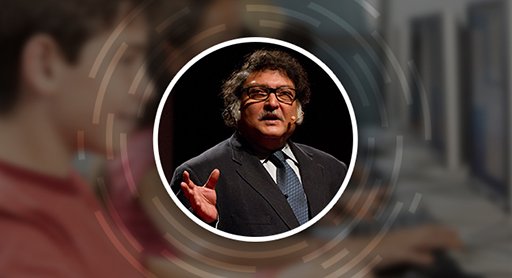2.1 The School in the Cloud
In the following audio recording Professor Sugata Mitra outlines his prize-winning School in the Cloud that works without teachers; it draws on a previous trial which he called his Hole in the Wall experiment. As you listen to Professor Mitra’s interview, think about whether you are convinced by his suggestion that technology can teach children without teachers’ involvement.
Download this audio clip.Audio player: ou_futurelearn_21st_c_childhood_aud_1052.mp3
Transcript
MONTAGUE
When my guest today put a computer in the wall of a Delhi slum, just as he expected, children crowded around and started pressing keys to see what it could do. What he did not expect was just how quickly they would learn from it. Mastering the technology so they could learn things online and learning English in the process. All without any adult involvement. And as he watched them he realised their success was not just down to the technology but to the fact that they were working together on problems, even benefiting from an adult not being there. That hole in the wall experiment inspired the story that became Slum Dog Millionaire and it inspired his latest project which he’s overseeing from here in Newcastle in which he goes much further because he thinks schools everywhere, both in what they teach and how they teach it, need reinventing for modern times. He is Sugata Mitra, Professor of Educational Technology at Newcastle University. Professor Mitra, welcome to The Educators.
MITRA
Thank you.
MONTAGUE
Now last year you won from the online lecture series TED a $1 million prize for a project that you wanted to do, which was to build what they’ve called Schools in the Cloud and as a result you are in the process of putting seven schools in the cloud. And the way they work – you call them SOLEs, which is Self-Organised Learning Environments, explain how they work now.
MITRA
The Self-Organised Learning Environment tries to simulate the chaotic environment of the hole in the wall experiment, which was computers outdoors with no supervision and children accessing it. The SOLE attempts to do the same inside the classroom. So you have a few computers, you have lots of children usually and you trigger the whole system off with a big question.
MONTAGUE
Give us an example.
MITRA
You could, for example, ask them why does hair grow? A typical nine year old would say what do you mean? So I’d say you know the hair on your head keeps growing longer and longer and longer and then you have to cut it off, why on earth does it do that? It doesn’t seem to do that on animals. And then the magic starts off.
MONTAGUE
So, what, you leave them alone in the room with a computer and they have to work out how to answer the question?
MITRA
We call these the big questions. A big question is something that a child is attracted by and to which preferably no one really has the right answer.
MONTAGUE
What answer did they come up with in that case?
MITRA
They came up with cell expression – nine year olds – that hair cells express on signals from the brain. And then they came up with insulation – apparently that’s about the best that they could get to and apparently that’s the best that scientists have gotten to.
MONTAGUE
Now one of the things you’ve established in these cases that you’re talking about, there’s no adult involvement, you did discover that actually sometimes children do need a bit of a help and this is where, what you’ve called the Granny Cloud comes in, which is this idea that there’s a little bit of help from the British granny, I think was your perfect model?
MITRA
Well that came out of an experiment in India which was designed to fail, I said I’ll give the children a task that is so hard that they couldn’t possibly do it. The task I chose was undergraduate level genetics in English for 12-year-old Tamil speaking children in an Indian village. I had a test at the end of it which they’ve gotten a zero aim to start with and they got 30 per cent. So I didn’t want to stop there, I said but how do I get that 30 up further with 30 as a fail? So what I got was a friendly local girl, she was 22 years old and a great friend of the children, they used to play together and she said, biotechnology, I don’t know anything about it, I didn’t even have science in school. I said Look you’re the best I have here, you don’t understand the subject, doesn’t matter, can you just go on encouraging them.
MONTAGUE
So go on what happened?
MITRA
Fifty per cent in two months.
MONTAGUE
Purely from the encouragement?
MITRA
Just from the encouragement.
MONTAGUE
So somebody just saying to the children well done, you’re doing really well and they carry on doing it and they get their score up?
MITRA
And well the classic sentence to me, which I’ll remember for the rest of my life, was apart from the fact that improper replication of the DNA molecule causes genetic disease we’ve understood nothing else. So but any how I came back to England and the Guardian was interviewing me for Slum Dog Millionaire, I said will you put in just a couple of lines at the bottom saying that if you are a British grandmother, if you have broadband and a web camera can you give me one hour of your time for free because I needed a million of them.
MONTAGUE
So you created this Granny Cloud effectively on the site.
MITRA
It became the Granny Cloud.
Interactive feature not available in single page view (see it in standard view).

